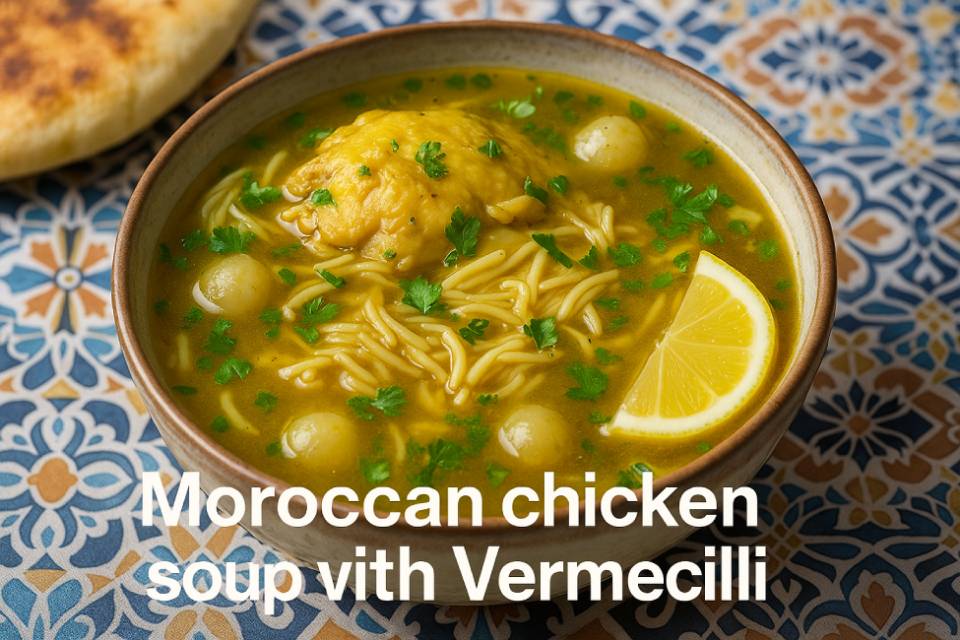Table of Contents
🥣 What Is Moroccan Chicken Soup (Chorba)?
A Traditional North African Comfort Food
Few dishes feel as inviting and soulful as a steaming bowl of Moroccan chicken soup, where delicate vermicelli and spiced broth come together perfectly. This dish goes beyond the plate; it carries generations of culinary wisdom, emotional warmth, and the essence of Moroccan home life in every bite.
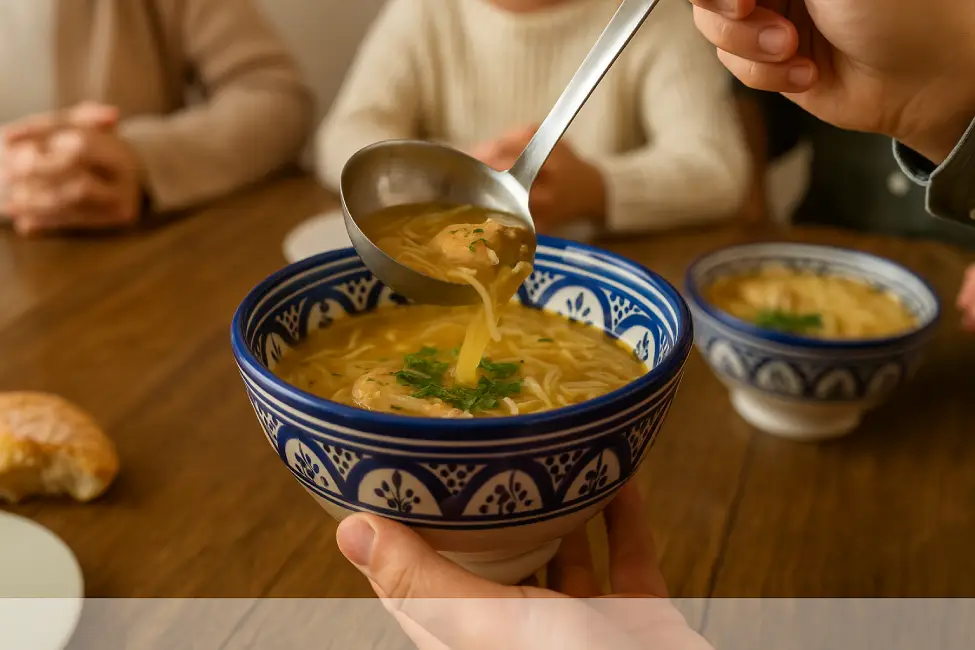
Known as Chorba in many Moroccan homes, this fragrant soup blends tender chicken, delicate vermicelli noodles, and warming spices in a way that speaks to both the stomach and the soul.
Rooted in North African cuisine, Chorba is a staple of Moroccan food traditions. It’s often the first thing served when families gather around the table during the cooler months or special occasions. Every spoonful tells a tale of simplicity, nourishment, and centuries-old flavor.
If you’ve ever wondered what makes Moroccan food so beloved worldwide, this soup is a perfect introduction. It’s not just nourishing physically; it’s deeply satisfying, thanks to its balance of spice, texture, and tradition.
This recipe captures the essence of Morocco in one bowl, something warm, grounding, and filled with intention. While it varies slightly from region to region, the heart of Chorba remains the same: chicken, vermicelli, onions, and a thoughtful mix of spices and herbs.
🔗 For a richer take on Moroccan soups, discover our Perfect Harira Recipe, A Step-by-Step Guide, another iconic dish enjoyed during Ramadan.
The Difference Between Chorba and Harira
People often confuse Chorba and Harira, and it’s easy to see why. Both are deeply comforting Moroccan soups, traditionally served at family meals and during Ramadan. Although Chorba and Harira have a few elements in common, they stand apart in their consistency, key ingredients, and the contexts they enjoy.
- What makes Chorba so unique is its gentle nature; the soup carries just enough warmth and flavor from the spices, balanced by silky noodles and soft chicken, creating a light but fulfilling experience.
- Harira, in contrast, has a heartier profile. Its consistency is richer, thanks to the addition of legumes like lentils and chickpeas, and it’s often simmered with red meat for deeper flavor.
Think of Chorba as the lighter, more delicate cousin, ideal when looking for something simple and soulful.
Want to dig deeper into Moroccan soups? You can explore more distinctions between North African dishes through this comprehensive culinary breakdown from The Spruce Eats, a trusted resource in international food culture.
When and Why It’s Commonly Served
If you’ve ever spent a winter evening in a Moroccan home, there’s a good chance you were welcomed with a steaming bowl of Chorba. During Ramadan evenings, it’s often the first thing shared at the iftar table, light enough to soothe an empty stomach yet flavorful sufficient to awaken the senses.
Its warmth, ease of digestion, and gentle flavors make it ideal after a long day of fasting.
But Ramadan isn’t the only time it shines. Chorba is also:
- A go-to comfort food when someone is feeling under the weather
- A nourishing starter for family dinner
- A way to warm up cold evenings with something wholesome and homemade
Families often prepare large batches in advance, letting the flavors develop overnight. It’s a dish that tastes even better the next day, making it a reliable and delicious meal-prep option.
So whether you’re looking for something comforting on a rainy day or want to experience a touch of Moroccan tradition at your table, this Moroccan chicken soup with vermicelli delivers flavor and familiarity.
🥘 Key Ingredients in Moroccan Chicken Vermicelli Soup
Knowing what goes into a truly flavorful Moroccan chicken soup is like uncovering the secret rhythm of a family kitchen. Each ingredient has a purpose; some bring depth, others offer aroma, and a few simply connect us to generations past. Let me walk you through what makes this soup both humble and unforgettable.
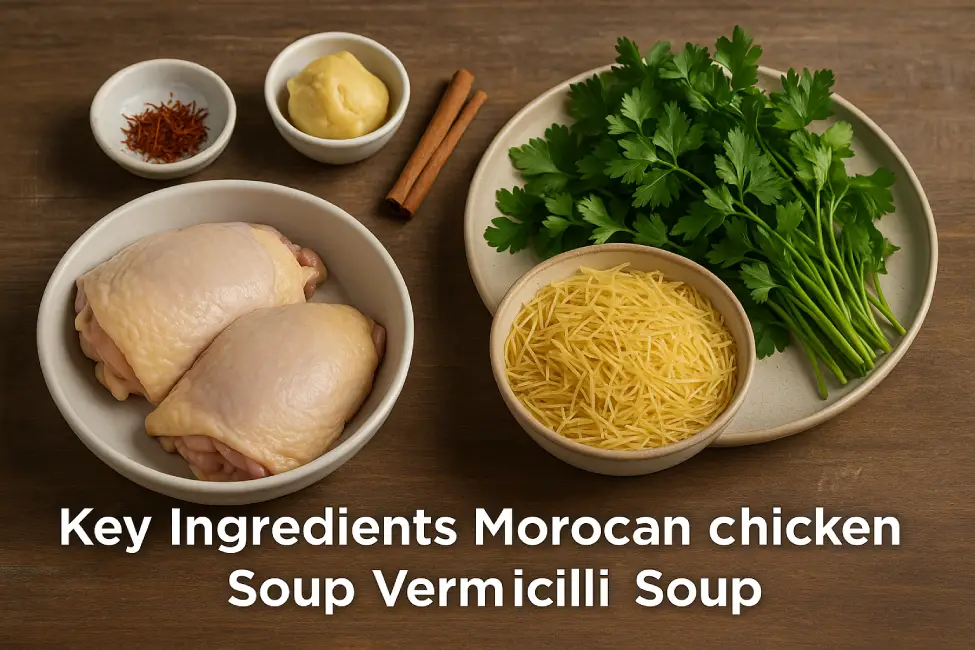
Chicken Thighs and Vermicelli Noodles
The base of this comforting soup begins with chicken thighs, not just for their tenderness but for the flavor they release as they simmer. Unlike leaner cuts like breast meat, thighs offer a richer, more satisfying taste and texture, especially when gently cooked in a broth.
Vermicelli noodles add body and warmth to the soup without overwhelming the dish. Their thin, delicate strands soak up the spices beautifully and provide enough substance to complete each bite. You’ll want to add them near the end of the cooking time to preserve their silkiness.
🔗 Looking for another slow-cooked Moroccan dish with rich flavor? Don’t miss our Authentic Tagine Cooking with Beef, Peas, & Artichokes, it pairs beautifully with warm soup.
Moroccan Spices: Saffron, Cinnamon, and Smen
This dish wouldn’t be Moroccan without its bold, fragrant spices. While the broth might look straightforward and unassuming, it’s infused with layers of complexity thanks to just a few carefully chosen elements.
- Saffron lends its signature golden hue and a subtle floral depth. Even a few threads are enough to transform the broth.
- Cinnamon stick introduces a touch of warmth and sweetness, not sugary, but in the comforting sense that lingers.
- And then there’s smen, a type of aged, fermented butter unique to Moroccan kitchens. It is used in moderation and adds a deep umami note that sets this soup apart from other chicken noodle recipes worldwide.
Want to explore how these spices impact traditional dishes’ body and flavor profiles? Healthline’s guide to Moroccan spices offers excellent insight into their nutritional and medicinal benefits.
Fresh Herbs: Parsley and Coriander
Fresh herbs are like the soul of this soup. A small bundle of parsley and coriander (cilantro), tied together and dropped into the pot during cooking, releases layers of brightness and earthiness.
Coriander, in particular, brings a citrusy edge that lifts the richness of the chicken and smen. Meanwhile, parsley adds a clean, green balance to the broth. Together, they help define the Moroccan flavor profile in a way no dried herb blend ever could.
If possible, always choose fresh over dried, and add a sprinkle of chopped herbs at the end for a beautiful, aromatic finish.
Optional Ingredients and Variations
One of the best things about Moroccan chicken soup is its versatility. Whether you’re cooking for a special occasion or just using what’s available, you can make minor adjustments without losing the spirit of the recipe.
Here are a few ideas:
- Add grated tomato or a spoonful of tomato paste for extra depth and acidity.
- Substitute chicken with turkey or even lamb for a bolder twist.
- Skip the smen for a lighter version if you prefer a more delicate broth.
- Include a handful of split chickpeas or lentils to boost the soup’s nutritional value, ideal for those following a healthy Mediterranean diet.
Playing with ingredients while keeping the core structure intact lets you discover that this healthy Moroccan soup recipe adapts beautifully to your needs and preferences.
🍲 Step-by-Step Guide: Cooking Moroccan Chicken Soup with Vermicelli
Making your own Moroccan chicken soup might seem simple at first glance, but carefully preparing each step is profoundly satisfying. From the base to the finishing touches, every layer adds to its comfort and charm. Let’s explore how you can bring this flavorful classic to life, one phase at a time.
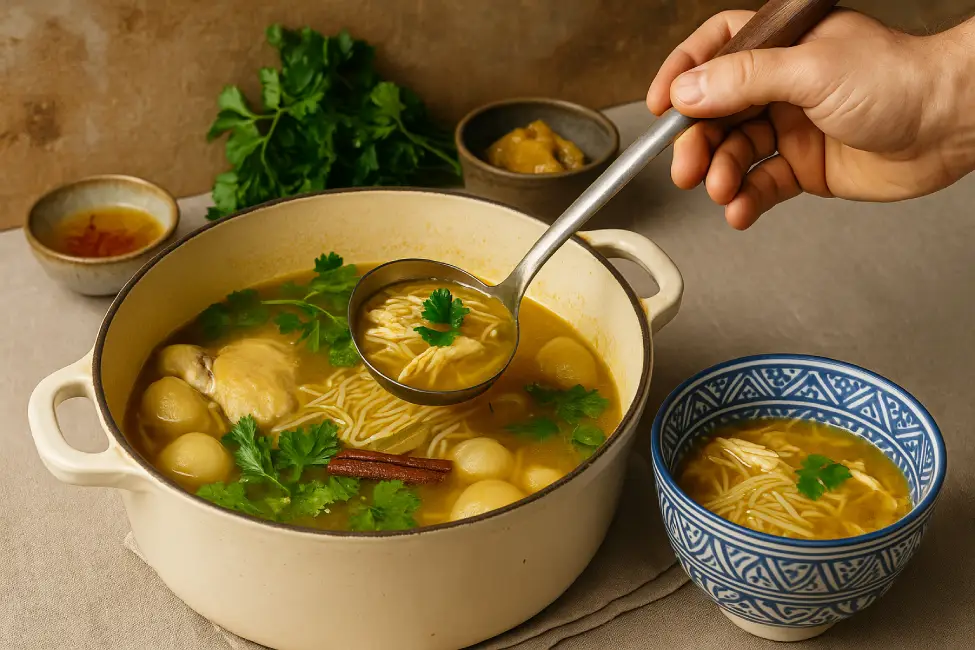
Building the Flavor Base: Sear and Simmer
To begin, gently heat a combination of olive oil and real butter in a large saucepan over low to medium heat. Add finely chopped onion and bone-in chicken thighs, and stir for a few minutes to allow the flavors to awaken and blend.
This gentle sauté is crucial. Rather than browning aggressively, you’re coaxing the depth from the meat and aromatics. Once the onions soften slightly and the chicken looks opaque, pour in about 1.5 liters of water, setting the stage for a deeply infused broth.
🔗 For another slow-cooked Moroccan comfort dish with bold flavor, check out this Beef Tagine with Artichokes and Fava Beans, a perfect pairing with a lighter soup like this one.
Seasoning with Spices, Greens, and Onions
Once your broth gently bubbles, it’s time to introduce the signature Moroccan aromatics.
Toss in:
- A small bouquet of fresh coriander and flat-leaf parsley, tied loosely to keep the stems intact
- One cinnamon stick for warm depth
- A pinch of sea salt, adjusted to taste
- A few threads of saffron, previously soaked in warm water to enhance its aroma
- Several peeled baby onions or small shallots left whole
Among these, saffron uniquely offers a subtle floral fragrance and a warm golden tint to the broth. If you’re interested in its broader benefits, WebMD’s research details how saffron supports emotional wellness, digestion, and more, another reason why it’s treasured in Moroccan kitchens.
Let the pot simmer on low for 35 to 40 minutes, letting all the flavors slowly blend and deepen.
Adding the Noodles and Enriching the Finish
Remove it carefully and set aside once the chicken is tender and easy to separate from the bone. While the soup continues to simmer, pour in medium-cut vermicelli slowly, stirring as you go to prevent it from sticking together.
Let the noodles cook gently for 8 to 10 minutes, just enough to soften without overcooking. Meanwhile, shred the chicken meat and discard the bones. Add the chicken back into the pot and stir in a small spoon of smen, a Moroccan-style fermented butter that brings umami depth to the dish.
If you’re seeking a lighter flavor profile or prefer a dairy-free version, feel free to leave out the smen and finish with a drizzle of extra virgin olive oil instead. The soup will still be rich and satisfying.
Smart Tips for Consistency and Taste
Want to make your easy chicken vermicelli soup stand out every time? These practical tips can help:
- Use medium vermicelli instead of fine, it better holds its texture in the broth.
- Let the soup rest for 5–10 minutes after cooking, covered, before serving. This helps the flavors meld naturally.
- Don’t skip soaking the saffron, it brings out its full aroma and color.
- Add a slice of fresh lemon to the table to balance the richness with brightness.
🎥 Prefer to watch instead? This helpful video from a YouTube creator shows exactly how Moroccan chicken soup is prepared, step by step:
👉 Watch on YouTube
Note: This video is from an external source and is not affiliated with Tajine Recipes. All credit goes to the original creator.
💡 To view subtitles in English: click the gear icon (⚙️), select “Subtitles/CC” → “Auto-translate” → “English”.
This soup adapts beautifully to your tastes and what’s in your pantry, always comforting, never complicated.
🔗 Craving more Moroccan soup inspiration? Explore our take on Fresh Bean Lamb Tagine, a wholesome dish loved across the country for its simplicity and depth.
🍽️ Serving Suggestions and Occasions
A bowl of Moroccan chicken soup doesn’t just satisfy hunger, it creates moments. Whether warming up on a cold evening or setting the table for a special occasion, this dish brings people together.
Let’s explore when and how to serve this comforting soup and how to turn it into a complete Moroccan experience at home.
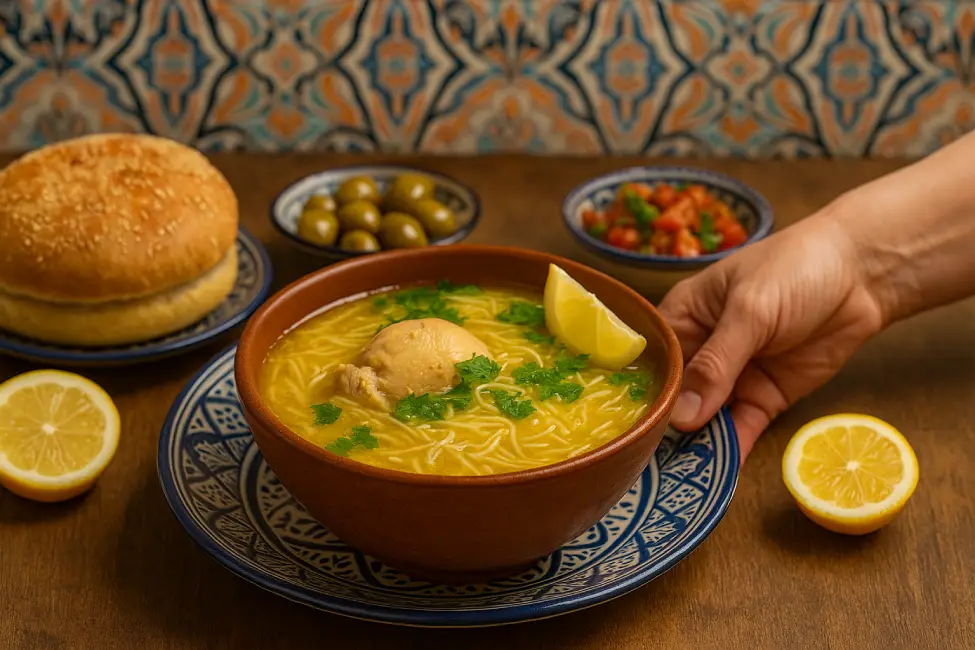
During Ramadan and the Winter Months
In Moroccan homes, Chorba often holds a special place during the holy month of Ramadan. At sunset, after a day of fasting, the soup is one of the first dishes served at iftar, soothing, hydrating, and gentle on the stomach. It’s warm without being heavy, making it the perfect opener for a larger meal.
But Chorba isn’t limited to Ramadan. It’s just as appreciated during winter when families crave something warm, light, and restorative. The combination of chicken, vermicelli, and fragrant broth makes it a natural choice for cozy evenings, especially when shared with loved ones around the table.
If you’ve ever had a steaming bowl after coming in from the cold, you know it brings more than just physical warmth, comfort and calm in every bite.
🔗 Looking for another winter-friendly Moroccan classic? Try our Slow-Cooked Moroccan Beef with Artichokes and Beans, it pairs beautifully with a starter like this soup.
What to Serve with Moroccan Chicken Soup
Consider the balance of textures and flavors to make Moroccan chicken soup part of a well-rounded dinner. Since the soup is light, the sides can add richness or crunch for contrast.
Here are a few classic pairings:
- Stuffed dates with almond paste or walnuts, sweet and soft, perfect for iftar
- Hard-boiled eggs with cumin and salt, simple, protein-rich, and flavorful
- Traditional Moroccan salads, like taktouka (tomato and pepper salad) or zucchini salad with garlic and olive oil
If you’re planning a full Moroccan dinner, serve the soup as an elegant starter before a main like tagine, couscous, or roasted lamb. Its mild nature makes it a flexible match for many bold dishes.
For inspiration on planning a complete meal with harmony and tradition, you can explore this guide to Moroccan dinner planning from The Spruce Eats, a trusted source for global cuisine.
Presentation: Garnish and Side Dishes
Presentation adds just as much joy to a meal as flavor, and this soup is no exception. Before serving, sprinkle freshly chopped coriander leaves on top. The herb adds color and brings a pop of brightness to the bowl.
Consider serving it with:
- Moroccan khobz (round semolina bread), perfect for dipping into the broth
- A slice of lemon on the side for guests who enjoy a citrusy twist
- A small bowl of green olives, lightly spiced, to nibble between spoonfuls
Keep the setting warm and simple. A clay bowl or rustic ceramic dish can echo the authenticity of Moroccan cooking and create a homey, inviting atmosphere.
This soup doesn’t need extravagant styling, just thoughtful touches that honor its origin and elevate the dining experience. Whether served during a celebration or an ordinary evening, it becomes a small celebration of flavor and care.
🔗 Want to round out your table with a Moroccan starter? Our Authentic Taktouka Recipe makes a bright and flavorful addition to any meal.
💛 Why This Moroccan Soup Is Nourishing and Special
Not all soups are created equal, and Moroccan chicken soup proves just that. It stands out for its delicate taste and comforting aroma and its role in health and heritage. Whether you’re cooking for yourself, your family, or guests at your table, this soup brings more than warmth, it brings meaning.
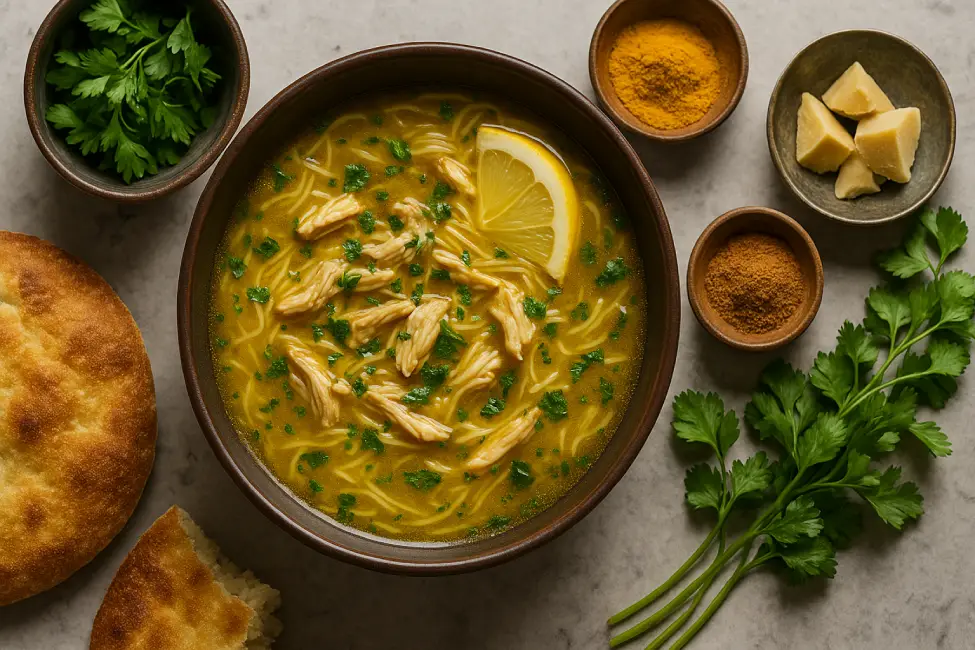
Nutritional Benefits of the Ingredients
At its core, this dish is a healthy North African soup that balances flavor with nourishment. Every component contributes to your well-being without complex ingredients or processed shortcuts.
Let’s look at what makes it so beneficial:
- Chicken thighs offer a good source of lean protein and iron, ideal for muscle recovery and immune health.
- Vermicelli noodles provide easy-to-digest carbohydrates, gentle on the stomach yet satisfying.
- Saffron is rich in antioxidants and linked to improved mood and digestion.
- Cinnamon offers anti-inflammatory benefits and helps regulate blood sugar.
- Including parsley and coriander boosts the dish with vitamins A, C, and K, all vital for skin, bones, and immune function.
This soup is light in fat (especially if you skip the smen), moderate in calories, and high in flavor. It’s suitable for people watching their intake but unwilling to compromise on richness or aroma.
🔗 To discover another traditional Moroccan soup known for its health value, try our Authentic Bissara Recipe, made from fava beans and olive oil, a staple of Mediterranean nutrition.
Cultural Significance of Chorba in Morocco
Beyond the bowl, Chorba holds deep roots in Moroccan tradition. It’s not just food, it’s a part of daily rituals, religious celebrations, and seasonal transitions.
- It’s one of the first dishes to gently break the fast during Ramadan.
- It offers warmth and togetherness in colder months, often cooked in big pots for the whole family.
- In rural communities, it’s passed down from generation to generation, with variations depending on regional herbs, spices, or proteins.
Preparing Chorba isn’t just about feeding people, it’s a gesture of care. In Moroccan culture, cooking and sharing this soup expresses affection, hospitality, and respect for tradition.
Want to learn more about the role of food in Moroccan society? This article from National Geographic explores how meals like Chorba reflect deeper cultural values.
Light Yet Filling: Ideal for All Ages
One of the reasons soup with chicken and noodles remains a universal comfort food is its adaptability, and Chorba embodies that beautifully. It’s light enough for young children or elders yet hearty enough to satisfy anyone after a long day.
- For kids: It’s soft, mild, and nourished, easy on sensitive stomachs.
- For adults: It’s a low-effort, high-reward meal you can prep ahead and enjoy all week.
- It’s gentle, hydrating, and soothing for elders or those recovering from illness.
Whether served as a starter or light dinner, Moroccan chicken soup has that rare balance, it feels cozy but never heavy, rich but not overwhelming.
A Perfect Balance of Flavor, Aroma, and Simplicity
The true beauty of this dish lies in its simplicity done well. A short list of everyday ingredients transforms, through slow simmering and care, into something layered and luxurious.
The spices don’t shout, they whisper in harmony. The texture is smooth but structured. And the overall experience feels like a warm embrace, familiar even if you’ve never tasted it before.
No need for extravagant techniques or rare imports. All you need is a pot, a few pantry staples, and a bit of time, and in return, you’ll get a soup that tells a story, nourishes the body, and honors the past.
🔗 Want a main dish to follow this bowl of comfort? Try our Flavorful Moroccan Chicken Tagine with Lemons and Olives, it pairs perfectly with this light and fragrant starter.
❓ Frequently Asked Questions
What makes Moroccan chicken soup different from regular chicken soup?
What truly sets Moroccan chicken soup apart is its use of warm, aromatic spices and vibrant herbs that create a more layered and fragrant profile than standard versions. While regular chicken soup is often seasoned with basics like salt, pepper, and celery, Moroccan chicken soup (Chorba) uses ingredients like saffron, cinnamon, coriander, and sometimes smen, a fermented butter that adds depth. The broth is lighter and more fragrant, thanks to the balance of warm spices and fresh herbs.
Can I make Moroccan chicken soup without vermicelli?
Absolutely. While vermicelli noodles are traditional and help give the soup body, you can replace them with orzo, small pasta shapes, or cooked rice if needed. The result will still be nourishing and flavorful. Just be sure to adjust the cooking time accordingly so your starch doesn’t overcook.
Is Moroccan chicken soup healthy?
Yes, especially when made with lean chicken thighs, fresh herbs, and natural spices. The broth is hydrating, and the ingredients provide protein, vitamins, and anti-inflammatory benefits. You can make it even lighter by using olive oil instead of smen and reducing the amount of noodles if you’re watching your carbs. It’s an excellent choice for anyone following a Mediterranean-style diet.
How long can I store Moroccan chicken soup?
Appropriately stored in an airtight container, Moroccan chicken soup can last up to 4 days in the refrigerator. In fact, Many find that the soup’s flavor deepens beautifully after a night in the fridge, making leftovers even more enjoyable. For more extended storage, you can freeze the broth alone for up to two months and add fresh noodles when reheating. Just add fresh noodles when reheating for the best texture.
Can I use chicken breast instead of thighs?
Yes, but with a small trade-off. Chicken breasts are leaner and cook faster, but they don’t offer the same depth of flavor or tenderness that bone-in thighs provide after slow simmering. If you choose breasts, add them later in the process and reduce cooking time slightly to avoid dryness.
Is Moroccan chicken soup suitable for Ramadan?
In fact, Chorba is one of the most traditional Ramadan dishes in Morocco. Its gentle broth helps rehydrate after fasting, and it’s easy on the stomach and satisfying. Serve it as a starter before heavier dishes during iftar for a balanced meal.
🧾 Final Thoughts: A Soup That Warms More Than Just the Body
Moroccan chicken soup is more than a recipe, it reflects culture, care, and comfort. From the first sauté of onions and spices to the last spoonful of silky vermicelli, every step of the process invites you to slow down and savor something simple yet deeply satisfying.
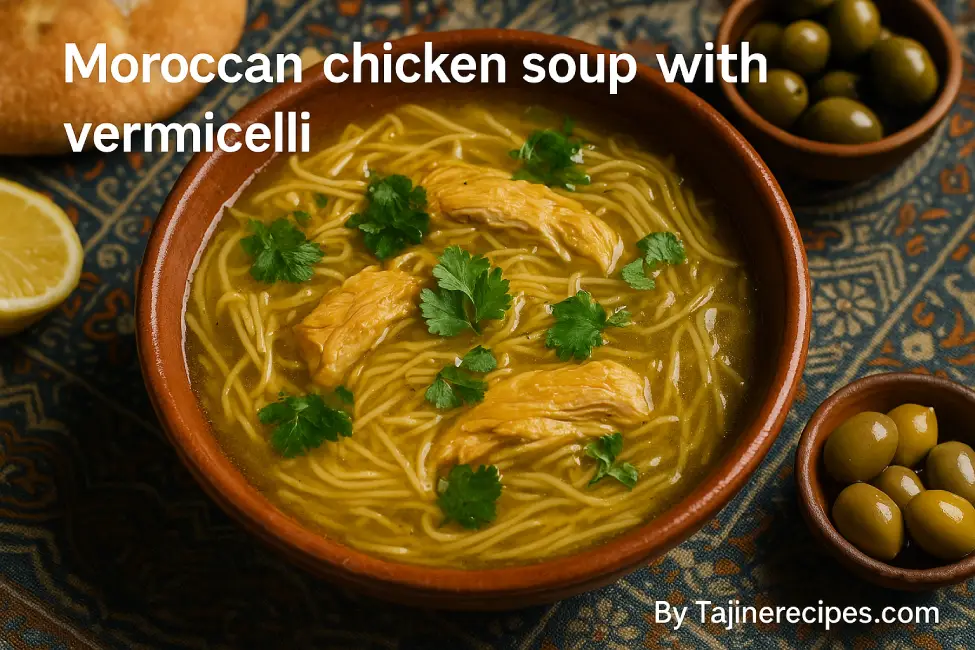
Whether you prepare it during Ramadan, on a cold winter night, or as part of a family dinner, this soup offers nourishment. It’s light without lacking depth, easy to prepare without being ordinary, and deeply rooted in Moroccan tradition.
More than that, it’s a dish you can truly make your own, adapting the spices, the richness, and the accompaniments to suit your table and your taste. By preparing this soup, you’re honoring a culinary tradition shared across generations, it’s cooking with heart, not just hands.
🔗 Ready to explore more comforting Moroccan dishes? Our Zesty Moroccan Meatballs Recipe brings similar warmth and bold flavor to your plate.
Suppose you’re curious about how soups like this one support wellness on a deeper level. In that case, this article from Cleveland Clinic explains the many benefits of homemade, whole-food meals, especially brothy dishes like Chorba.
Now it’s your turn to try it. Take a moment to assemble your ingredients, cook slowly, and appreciate each part of the process, the reward is in both the ritual and the result.
Because when you serve Moroccan chicken soup, you’re offering more than just food, you’re serving comfort, heritage, and a taste of something timeless.

Nourishing Moroccan Chicken Soup with Vermicelli, Made Simple
Ingredients
🧂 Ingredients
- 4 bone-in chicken thighs skin removed
- 1 tablespoon olive oil
- 1 tablespoon butter or smen for authentic flavor
- 1 small onion finely chopped
- 6 –8 baby onions or small shallots peeled
- 100 g medium vermicelli noodles
- 1 small bunch parsley tied together
- 1 small bunch coriander tied together
- 1 cinnamon stick
- A few threads of saffron soaked in warm water
- Salt to taste
- 1.5 liters water
- Optional: 1 tsp smen for finishing
- Optional: 1 tbsp tomato paste or grated tomato
- Optional: lemon wedges for serving
Instructions
🍲 Instructions
- Sauté the Base:
- In a deep pot, heat olive oil and butter over medium heat. Add chopped onion and chicken thighs. Stir for 3–5 minutes until onions are soft and chicken is slightly browned.
- Add Aromatics:
- Pour in water. Add baby onions, tied parsley and coriander, cinnamon stick, saffron (with water), and salt. Cover and let it simmer for 35–40 minutes on low heat.
- Remove and Shred Chicken:
- Carefully remove chicken thighs, shred the meat, discard the bones, and set aside.
- Cook Vermicelli:
- Add vermicelli to the broth. Stir occasionally and cook for 8–10 minutes until tender.
- Final Touches:
- Return shredded chicken to the pot. Stir in a spoon of smen for deeper flavor or skip for a lighter broth. Simmer 2–3 more minutes.
- Serve:
- Garnish with chopped coriander or parsley and serve hot with lemon wedges and warm Moroccan bread.
Notes
- For a lighter version, use only olive oil and skip smen.
- You can substitute vermicelli with orzo or small pasta.
- This soup freezes well without vermicelli; add noodles fresh when reheating.
- Ideal for Ramadan, meal prep, or as a cold-weather comfort dish.
- Pairs beautifully with Moroccan salads or dates during Iftar.
Parfait ! Voici la section “Nutrition Information” pour ta fiche recette (Moroccan Chicken Soup with Vermicelli) au format simple, lisible et en anglais :
🧾 Nutrition Information (per serving)
| Calories | 295 kcal |
| Protein | 21 g |
| Carbohydrates | 28 g |
| Sugars | 3 g |
| Fiber | 2.5 g |
| Fat | 12 g |
| Saturated Fat | 4 g |
| Cholesterol | 65 mg |
| Sodium | 620 mg |
| Potassium | 460 mg |
| Vitamin A | 18% DV |
| Vitamin C | 14% DV |
| Iron | 10% DV |
| Calcium | 6% DV |
Note: These values are approximate and based on a 2,000 calorie diet. Nutritional content may vary depending on the exact ingredients and portions used.
💬 Stay Connected with TajineRecipes
Love this Moroccan Chicken Soup with Vermicelli?
We’d love to see your version! 📸
Tag us when you recreate this recipe or share your own family twist, it warms our hearts to see our dishes come to life in your kitchen.
👉 Follow us on social media for more comforting Moroccan recipes, weekly inspirations, and behind-the-scenes from our kitchen to yours:
From our table to yours, thank you for cooking with us 💛
📬 Join Our Delicious Journey, Subscribe to the Newsletter
Craving more cozy recipes like this Moroccan Chicken Soup with Vermicelli?
Sign up for our Tajine Recipes Newsletter and be the first to receive:
- 🥘 Exclusive traditional Moroccan recipes straight to your inbox
- 🌿 Seasonal tips, ingredient spotlights & kitchen wisdom
- 📅 Our Sunday Recipe Drop, a comforting dish delivered weekly
- 🎁 Early access to future eBooks, surprises & more
No spam, just warmth, inspiration, and real food from our table to yours.
Let’s make every meal special, together. 💛
📩 Join Our Moroccan Foodie Community
Get the best Moroccan tagine recipes and seasonal culinary tips straight to your inbox.
💬 Share Your Thoughts & Kitchen Stories
Have you tried this Moroccan Chicken Soup with Vermicelli?
We’d love to hear from you!
👇 Leave a comment below and tell us:
- How did it turn out for you?
- Did you add your own twist or family tradition?
- Any tips you’d like to share with our community?
Your feedback helps others (and us!) bring more flavor, warmth, and joy to the table.
Let’s keep the conversation cooking 🍲✨
